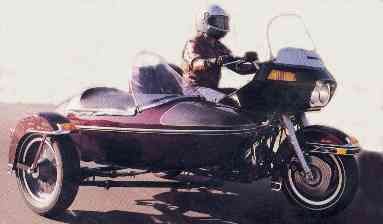-A- Regular side-car for the road:
Many persons cannot imagine life without a side-car:
If you must carry a third person, like a child for a couple that loves riding, the component layout with a side-car can be a solution. And if a city police has a motorcycle, adding a side-car lets a policeman ride even during winter on the snow, as long as it’s at slow speeds like during a parade.
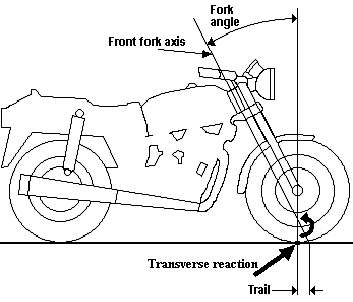 But there is a first major problem with this component layout:
But there is a first major problem with this component layout:
The motorcycle never is designed specifically to be exclusively used with a side-car.
Just the opposite, the motorcycle is designed with a typical motorcycle front fork geometry, with a ‘Fork angle’ and a ‘Trail’:
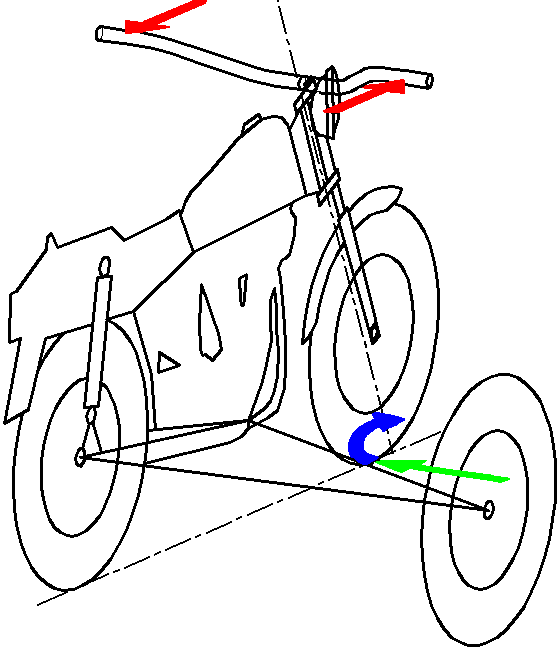 So in a curve with a motorcycle that stays upright because of it’s side-car, the centrifugal force generates a transverse reaction (along the green arrow) at the front tire contact patch on the ground, at a distance from the Front fork axis.
So in a curve with a motorcycle that stays upright because of it’s side-car, the centrifugal force generates a transverse reaction (along the green arrow) at the front tire contact patch on the ground, at a distance from the Front fork axis.
In order to avoid this transverse reaction from turning the steering wheel (around the blue arrow) and handlebar, the rider has to counteract it by pushing on the handlebar (along the red arrows).
The force exerted on the handlebar is so great that the rider has difficulty holding the handlebar of a regular motorcycle in a curve.
Moreover, the vehicle is not symmetrical like a 4-Wheeler is. So, going over road holes and bumps and breaking with the side-car wheel, generates additionnal undesirable reactions on the handlebar.
Thus, a motorcycle with a side-car has a heavy steering with undesirable reactions.
Also, there is a second major problem with this component layout:
This 3-Wheeler layout certainly offers more safety to it’s riders since it cannot fall on one of these riders’ legs.
But the center of gravity of the rider-vehicle system is high so that in a curve, the vehicle can easily overturn, even more easily if the brakes are applied while turning. It’s the exact reason why the off-road one-front-wheel 3-Wheelers of the 1980’s have been removed from the market.
Some may add that we don’t hear much about roadworthy 3-Wheelers having overturned. But this may be due to the fact that there are few motorcycles with side-car on the roads. Also, the first heavy-steering problem holds riders against turning fast in curves, thus limiting the risk of overturning. So the importance of the first problem limits the importance of the second. But they still are both present: Thus, if a rider has to react fast to avoid an obstacle, either he voluntary avoids holding the handlebar to avoid overturning, either he cannot hold the handlebar, or he overturns. Either of these posibilities results anyways in an accident.
So, due to its two major problems, a side-car degrades the handling of a conventional motorcycle.
-B- Side-car racers: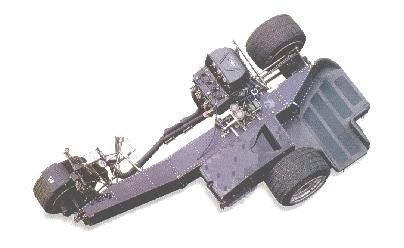

Sidecar racers are different because their chassis is better designed: The ‘side-car’ part can be integrated into the rest of the vehicle and the steering can be designed for a 3-Wheeler instead of a 2-Wheeler motorcycle.
This take care of the first problem of heavy steering with undesirable reactions.
But it doesn’t solve the second rollover propensity problem. In order to solve it, riders have to lean and even lay horizontally when going into curves, to lower the passenger-vehicle center of gravity:

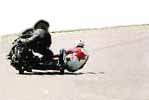
Their use is thus limited to races where the two riders are very agressive.
Conclusion:
This 3-Wheeler component layout with side-car presents little interest for general public usage.

